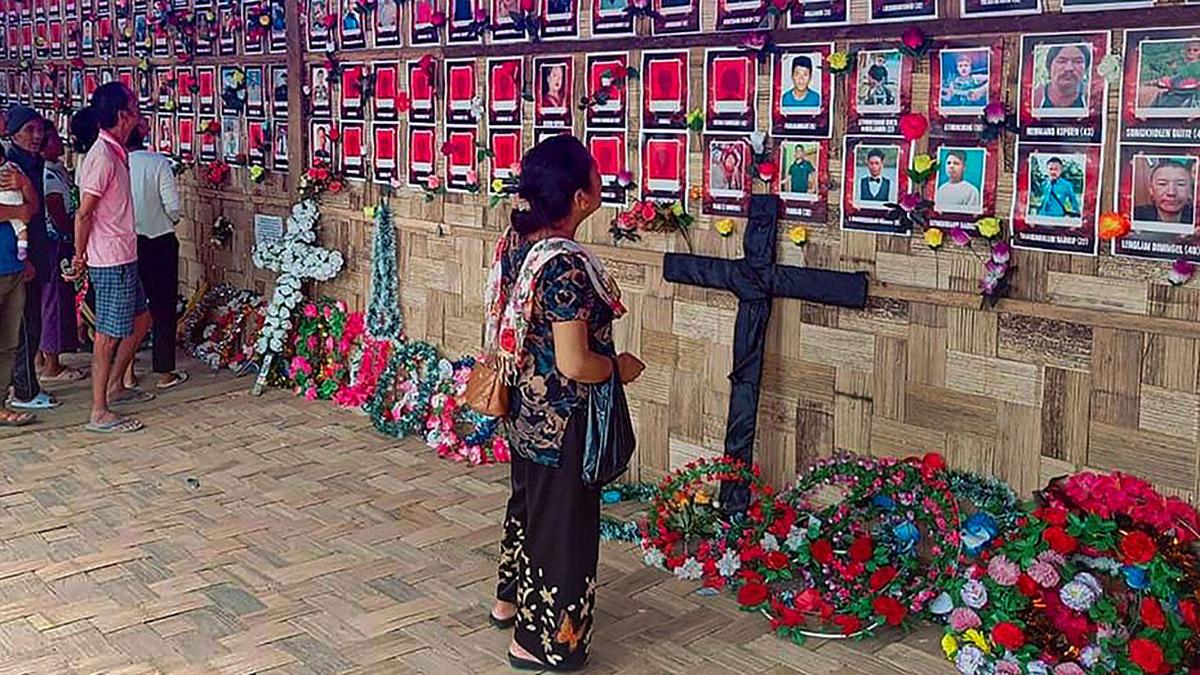Residents visit the ‘Wall of Remembrance’ in Churachandpur erected to honour lives lost during the ongoing conflict in Manipur. File
| Photo Credit: PTI
Sharad Leishangtham, 46, lost everything — from his home to his livelihood — in the ethnic violence that ravaged Manipur on May 3, 2023. Forced to live at a relief camp in Bishnupur, several kilometres away from his now-flattened home at Churachandpur, Leishangtham sells sugar cane juice by the roadside.
More than 250 people have been killed in the violence that erupted between the tribal Kuki Zo and the Meitei people in the north-eastern State in 2023. During a recent visit to Manipur after President’s Rule was imposed on February 13, I met Leishangtham while he was busy preparing to serve juice to customers. I was struggling to understand the Meiteilon language that another victim of the violence, a woman selling vegetables, was speaking when Leishangtham chipped in. In his broken Hindi, he translated what the woman said. As I jotted down notes, he churned fresh sugar cane sticks in the machine and brought me a glass of fresh juice. I told him that I had not asked for it. Leishangtham simply smiled and insisted that I drink it. As he also refused to allow me to pay for the juice, I had to forcibly put some money in his pocket. Even in times of adversity, knowing well that his daily earnings were essential for the survival of his family of six who are staring at an uncertain future, Leishangtham extended me this hospitality.
I then requested him to speak on video about his expectations from the government. When I asked whether he had any grievances, he said in a choked voice, “There should be no more fighting. We will not achieve anything by fighting. This is all I want to say.”
In 2019, after the dilution of Article 370 on August 5, I was sent to Kashmir Valley to report on the situation amid a security and information blockade. There was no Internet. As constitutional changes were to be introduced in the former State, thousands of people had been picked up and placed under preventive detention.
Outside the Shopian police station in South Kashmir, I met a group of men. One of them, Gulzar Ahmad Wagey, was looking for his 11-year-old son, who he had not seen for 22 days. Wagey said his son had been picked up by security forces in the last week of August from their home. Since then, he had been coming to the police station every day to know his son’s whereabouts.
I took down these details. As I was about to leave, Wagey offered me food. He said he was concerned that I had come all the way from Delhi and would not have had anything to eat since a security lockdown was in force in the entire area. His house was just a few metres away. He told me that he would be happy to serve me lunch at home. His gesture and his ability to rise above his personal tragedy and be welcoming to a complete stranger moved me deeply.
As reporters, it is easy to become cynical, but people like Leishangtham and Wagey tend to reinforce our belief in humanity. While adversity is often associated with negative feelings such as bitterness and anger, it can equally elicit compassion or help people double down on their long-held beliefs and values.
Leishangtham and Wagey are also reminders that they are not mere statistics. Leishangtham is not just one among the 62,000 people who have been forced to live away from their homes, 22 months after violence erupted in his State. Similarly, Wagey deserved a reply on the location of his son. Their voices remind the establishment of its duties.
These two victims, along with others, opened their hearts and homes to me because I was a journalist who was willing to listen to what they had to say and write their stories. Interacting with them also served as a reminder for me that journalism is not a mere chronicling of incidents and events; it is a public service.
vijaita.singh@thehindu.co.in
Published – March 28, 2025 01:24 am IST

